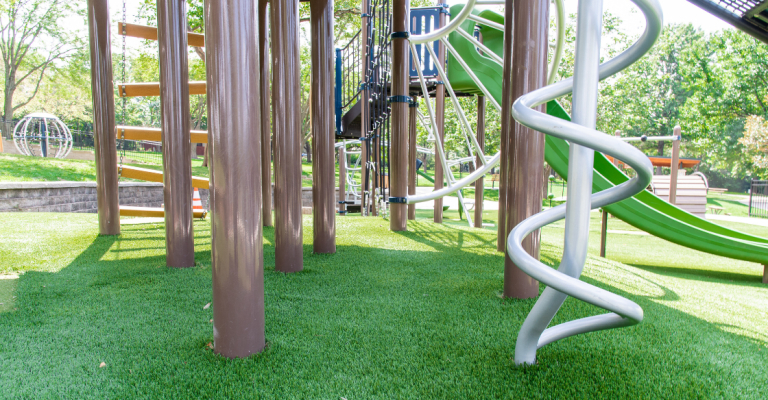Creating a backyard playground is one of the best ways to encourage outdoor play and help your children develop important skills. Whether you have a large yard or a small space, with the right planning, you can design a playground that is both fun and functional. More importantly, safety should always be your top priority. Here’s how you can create a safe and stylish playground that will keep kids entertained for hours.
1. Start with a Plan
Before diving into the construction of your backyard playground, it’s important to plan the layout. Start by measuring the space available and considering how much room you have for playground equipment, pathways, and seating areas. Think about how the playground will integrate with the rest of your backyard, ensuring that it doesn’t crowd your garden or outdoor living spaces.
Consider the types of equipment you want to include. Popular choices for backyard playgrounds are:
- Swings and Slides: Classic favorites for kids of all ages.
- Climbing Structures: Playhouses, jungle gyms, or rope ladders.
- Sandboxes: A low-maintenance option for younger kids.
- Merry-Go-Rounds: For added fun, though they do require extra safety precautions.
Take into account your child’s age and interests. A variety of activities will help engage children of different developmental stages. For example, if you have younger children, you might focus on soft, low-to-the-ground play equipment, while older kids might enjoy higher structures and more challenging activities.
2. Choose Safe, High-Quality Materials
Safety should always come first when creating a backyard playground. This includes using materials that are not only sturdy but also safe for kids to play on.
- Wood: Pressure-treated wood is a popular choice for playground equipment because it’s durable and can be easily shaped into various structures. However, ensure that the wood is free from splinters, cracks, or sharp edges. Sanding down rough patches and applying non-toxic sealants can help maintain a smooth finish.
- Plastic: Slides, climbing structures, and swings made from high-density polyethylene (HDPE) plastic are lightweight, durable, and safe for kids. Plastic is also easy to clean and resistant to rot, making it ideal for outdoor use.
- Rubber: For the ground surface, rubber mats or tiles are an excellent safety feature. They provide cushioning in case of falls, reducing the risk of injury. If rubber isn’t your preference, wood mulch or pea gravel can also work as long as they are regularly maintained.
When shopping for playground materials, always prioritize items that are designed specifically for children’s play. Avoid using materials that are sharp, toxic, or that could break easily under pressure.
3. Ensure Proper Grounding and Soft Surfaces
To reduce the likelihood of injury during playtime, it’s essential to have the proper grounding beneath the equipment. Grass alone doesn’t provide sufficient cushioning, and hard surfaces like concrete can be dangerous.
As mentioned, rubber is a great option for creating a soft landing, but you can also consider other alternatives like:
- Wood Chips or Mulch: A natural and aesthetically pleasing option that also provides cushioning. In Salt Lake City, playground wood chips are a great option, providing both safety and an attractive, earthy look for your outdoor play area.
- Pea Gravel: Small, rounded stones that create a soft landing area while offering good drainage.
Make sure that the material you choose is spread at least six feet around all play structures, or more for higher structures like climbing towers or swings. This provides a safe area for kids to land if they happen to fall.
4. Design with Style in Mind
While safety is paramount, your backyard playground doesn’t have to compromise on style. Think of the playground as a feature of your outdoor space that enhances the overall aesthetic of your yard. There are plenty of ways to blend functional playground elements with beautiful design:
- Natural Colors: Choose materials in natural, earthy tones that blend seamlessly with your garden or landscaping. Wooden playhouses and swings, along with neutral-colored rubber mats or mulch, create a harmonious look in your outdoor space.
- Themed Designs: Consider incorporating a theme into your playground design to add an extra element of fun. Whether it’s a pirate ship, a castle, or a jungle, themed play areas can make the space feel magical for children while complementing your garden’s overall style.
- Landscaping: Integrate plants and greenery around the playground to soften the edges and create a more inviting atmosphere. Flowering plants, hedges, and shrubs can create privacy and add beauty while ensuring that the playground doesn’t feel like it’s dominating the entire yard.
- Seating and Shade: Include a shaded area nearby, such as a pergola or an umbrella, where you can sit and supervise your children. Comfortable seating for adults will make it easier for you to relax and enjoy watching the kids play.
5. Regular Maintenance and Safety Checks
Once your playground is set up, maintenance will be key to keeping it safe and stylish. Regularly inspect the equipment for any wear and tear, particularly if it’s made of wood. Look for loose bolts, rusted parts, or cracked plastic that could pose a safety hazard. Check the ground surface for any uneven areas or exposed sharp objects.
Additionally, make sure to maintain the surrounding landscape. Trim trees or bushes that could create hazards or obstruct play, and regularly rake and refresh mulch or rubber surfaces to keep them clean and functional.
When prioritizing rubber playground flooring safety, playground mats emerge as a standout choice.
In Conclusion
A backyard playground that is both safe and stylish can provide endless fun for your kids while adding charm to your outdoor space. By planning carefully, choosing the right materials, and maintaining the area, you can create a playground that will be enjoyed for years to come. So go ahead, turn your backyard into a vibrant play space that encourages imagination, physical activity, and endless outdoor adventures!

